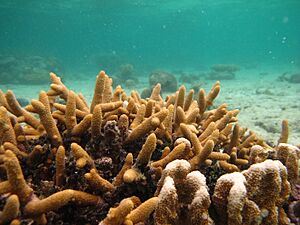Acropora aspera facts for kids
Quick facts for kids Acropora aspera |
|
|---|---|
 |
|
| Conservation status | |
| Scientific classification | |
| Synonyms | |
|
List
|
Acropora aspera is a type of coral known as a staghorn coral. It belongs to the Acroporidae family. You can find this coral in very shallow waters. It lives on flat parts of coral reefs and in calm, shallow lagoons. It is found in the western parts of the Indo-Pacific Ocean.
Contents
What Does Acropora aspera Look Like?
Acropora aspera is a colonial coral. This means it is made up of many tiny animals living together. It grows in low clumps with thin branches. Its branches are slender and get narrower at the ends.
Tiny stony cups called corallites are packed close together. These are where the coral's soft parts, called polyps, grow. Each cup has a small lip that sticks out. This coral can be different colors. It might be pale green, grey, or brown. Sometimes, it can even be a light blue color.
Where Does Acropora aspera Live?
You can find Acropora aspera in the Indian Ocean and the western Pacific Ocean. It lives on flat areas of coral reefs. It also grows in calm, shallow lagoons. This coral usually lives in water up to 5 meters (about 16 feet) deep.
On reefs, different corals live in different zones. Acropora aspera often lives between two other similar corals. It is found between Acropora pulchra, which prefers shallower water, and Acropora millepora, which lives in deeper water.
How Does Acropora aspera Live?
Acropora aspera is a special type of coral. It has tiny algae called zooxanthellae living inside its tissues. This is a symbiotic relationship, meaning both the coral and the algae help each other. The algae use sunlight to make food through photosynthesis. The coral gets a lot of its energy from this food.
Scientists studied this coral off the coast of southern India. They found that it grows all year long. It grows by making its branches longer and by adding to its stony skeleton. However, its growth slows down from June to September. This is during the south-west monsoon season. Less sunlight reaches the coral then because of more clouds and muddy water. This means the algae make less food, which slows the coral's growth.
Is Acropora aspera in Danger?
The IUCN Red List of Threatened Species lists Acropora aspera as "Vulnerable". This means it is at risk of becoming endangered. Even though it lives in a wide area, it is not very common. Scientists believe its numbers are going down.
This coral is very sensitive to bleaching. Bleaching happens when the ocean water gets too warm or the coral is stressed. The coral then pushes out its helpful algae and turns white. If the stress lasts too long, the coral can die.
Other dangers to Acropora aspera include:
- The overall destruction of coral reefs.
- Ocean acidification, which makes it harder for corals to build their skeletons.
- High ocean temperatures.
- Coral diseases.
The Crown-of-thorns starfish also poses a threat. These starfish love to eat Acropora corals. Sometimes, their populations grow very quickly. When this happens, they can cause a lot of damage to Acropora aspera in local areas.
See Also


